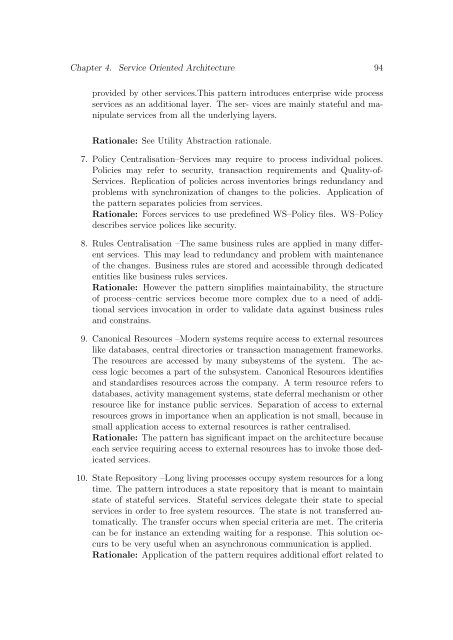Migration of a Chosen Architectural Pattern to Service Oriented ...
Migration of a Chosen Architectural Pattern to Service Oriented ...
Migration of a Chosen Architectural Pattern to Service Oriented ...
Create successful ePaper yourself
Turn your PDF publications into a flip-book with our unique Google optimized e-Paper software.
Chapter 4. <strong>Service</strong> <strong>Oriented</strong> Architecture 94provided by other services.This pattern introduces enterprise wide processservices as an additional layer. The ser- vices are mainly stateful and manipulateservices from all the underlying layers.Rationale: See Utility Abstraction rationale.7. Policy Centralisation–<strong>Service</strong>s may require <strong>to</strong> process individual polices.Policies may refer <strong>to</strong> security, transaction requirements and Quality-<strong>of</strong>-<strong>Service</strong>s. Replication <strong>of</strong> policies across inven<strong>to</strong>ries brings redundancy andproblems with synchronization <strong>of</strong> changes <strong>to</strong> the policies. Application <strong>of</strong>the pattern separates policies from services.Rationale: Forces services <strong>to</strong> use predefined WS–Policy files. WS–Policydescribes service polices like security.8. Rules Centralisation –The same business rules are applied in many differentservices. This may lead <strong>to</strong> redundancy and problem with maintenance<strong>of</strong> the changes. Business rules are s<strong>to</strong>red and accessible through dedicatedentities like business rules services.Rationale: However the pattern simplifies maintainability, the structure<strong>of</strong> process–centric services become more complex due <strong>to</strong> a need <strong>of</strong> additionalservices invocation in order <strong>to</strong> validate data against business rulesand constrains.9. Canonical Resources –Modern systems require access <strong>to</strong> external resourceslike databases, central direc<strong>to</strong>ries or transaction management frameworks.The resources are accessed by many subsystems <strong>of</strong> the system. The accesslogic becomes a part <strong>of</strong> the subsystem. Canonical Resources identifiesand standardises resources across the company. A term resource refers <strong>to</strong>databases, activity management systems, state deferral mechanism or otherresource like for instance public services. Separation <strong>of</strong> access <strong>to</strong> externalresources grows in importance when an application is not small, because insmall application access <strong>to</strong> external resources is rather centralised.Rationale: The pattern has significant impact on the architecture becauseeach service requiring access <strong>to</strong> external resources has <strong>to</strong> invoke those dedicatedservices.10. State Reposi<strong>to</strong>ry –Long living processes occupy system resources for a longtime. The pattern introduces a state reposi<strong>to</strong>ry that is meant <strong>to</strong> maintainstate <strong>of</strong> stateful services. Stateful services delegate their state <strong>to</strong> specialservices in order <strong>to</strong> free system resources. The state is not transferred au<strong>to</strong>matically.The transfer occurs when special criteria are met. The criteriacan be for instance an extending waiting for a response. This solution occurs<strong>to</strong> be very useful when an asynchronous communication is applied.Rationale: Application <strong>of</strong> the pattern requires additional effort related <strong>to</strong>
















